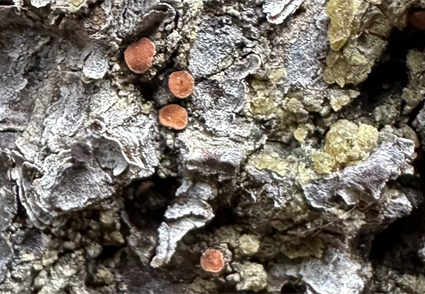Abstract
Sarea cirrhendocarpa, a resinicolous fungus, is here described as new to science from two specimens collected in the Indian Peaks Wilderness (Arapaho-Roosevelt National Forest, Colorado, USA) during the summer of 2023, a third specimen from Holy Cross Wilderness (White River National Forest, Colorado, USA) during the summer of 2024, and a fourth specimen from the Kachina Peaks Wilderness (Coconino National Forest, Arizona, USA) that was collected in 1998. The new species is readily distinguished from its closest relative, Sarea resinae, by its larger apothecia, smaller asci, smaller ascospores, and burnt orange hymenium (bicolored towards uppermost portions) among other traits. A phylogeny derived from the nuclear ribosomal internal transcribed spacer (ITS) region suggests that S. cirrhendocarpa is sister to and genetically distinct specimens of Sarea resinae sampled from around the world including North America. These molecular results in combination with the clear morphological differences lead us to propose this as a new species so far only known from the southern Rocky Mountains of North America. This new taxon is placed for the time being within the genus Sarea owing to inconclusive phylogenetic and morphological evidence that would support generic separation within the Sareomycetes. The name Sarea resinae is retained and new combinations for S. klamathica and S. lignicola are provided.
References
- Ayers, T.T. (1941) Biatorella resinae: the perfect stage of Zythia resinae. Mycologia 33 (1): 130. https://doi.org/10.1080/00275514.1941.12020800
- Bachman, S., Moat, J., Hill, A.W., De La Torre, J. & Scott, B. (2011) Supporting red list threat assessments with GeoCAT: geospatial conservation assessment tool. ZooKeys 150: 117–126. https://doi.org/10.3897/zookeys.150.2109
- Beimforde, C., Schmidt, A.R., Rikkinen, J. & Mitchell, J.K. (2020) Sareomycetes cl. nov.: A new proposal for placement of the resinicolous genus Sarea (Ascomycota, Pezizomycotina). Fungal Systematics and Evolution 6 (1): 25–37. https://doi.org/10.3114/fuse.2020.06.02
- Díaz-Escandón, D., Tagirdzhanova, G., Vanderpool, D., Allen, C.C., Aptroot, A., Češka, O., Hawksworth, D.L., Huereca, A., Knudsen, K., Kocourkova, J., Lücking, R., Resl, P. & Spribille, T. (2022) Genome-level analyses resolve an ancient lineage of symbiotic ascomycetes. Current Biology 32 (23): 5209–5218. https://doi.org/10.1016/j.cub.2022.11.014
- Doyle, J.J. & Doyle, J.L. (1987) A rapid DNA isolation procedure for small quantities of fresh leaf tissue. Phytochemical Bulletin 19: 11–15.
- Edler, D., Klein, J., Antonelli, A. & Silvestro, D. (2020) raxmlGUI 2.0: a graphica intervace and toolkit for phylogenetic analysis using RaxML. Methods in Ecology & Evolution 12: 373–377. https://doi.org/10.1111/2041-210X.13512
- Fries, E.M. (1815) Observationes mycologicae (Vol. 1). Havniae: Sumptibus Gerhardi Bonnier, Copenhagen. https://doi.org/10.5962/bhl.title.112534
- Fries, E.M. (1825) Systema orbis vegetabilis. Primas lineas novae constructionis periclitatur. Pars I. Plantae homonemeae. Lunde: E Typographia Academica
- Gaya, E., Fernández-Brime, S., Vargas, R., Lachlan, R.F., Gueidan, C., Ramírez-Mejía, M. & Lutzoni., F. (2015) The adaptive radiation of lichen-forming Teloschistaceae is associated with sunscreening pigments and a bark-to-rock substrate shift. Proceedings of the National Academy of Sciences 112 (37): 11600–11605. https://doi.org/10.1073/pnas.1507072112
- Gough, L.P. (1975) Cryptogam Distributions on Pseudotsuga menziesii and Abies lasiocarpa in the Front Range, Boulder County, Colorado. The Bryologist 78 (2): 124–145. https://doi.org/10.2307/3242043
- Hashimoto, A., Masumoto, H., Endoh, R., Degawa, Y. & Ohkuma, M. (2021) Revision of Xylonaceae (Xylonales, Xylonomycetes) to include Sarea and Tromera. Mycoscience 62 (1): 47–63. https://doi.org/10.47371/mycosci.2020.11.001
- Hawksworth, D.L. & Sherwood, M.A. (1981) A reassessment of three widespread resinicolous discomycetes. Canadian Journal of Botany 59 (3): 357–372. https://doi.org/10.1139/b81-049
- Hawksworth, D.L. (1980) Sarea resinae.[Descriptions of Fungi and Bacteria]. Descriptions of Fungi and Bacteria 68: Sheet 677.
- Hansen-Bristow, K.J. & Ives., J.D. (1985) Composition, Form, and Distribution of the Forest-Alpine Tundra Ecotone, Indian Peaks, Colorado, USA (Zusammensetzung, Form und Verbreitung des Übergangssaumes zwischen der Waldstufe und der alpinen Tundrastufe im Indian Peaks Gebiet, Front Range, Colorado, USA). Erdkunde 39 (4): 286–295. https://doi.org/10.3112/erdkunde.1985.04.04
- IUCN. (2012) IUCN Red List Categories and Criteria. Version 3.1. Second edition. Gland, Switzerland and Cambridge, UK: IUCN. iv + 32 pp.
- IUCN. (2022) Guidelines for using the IUCN Red List Categories and Criteria. Version 15.1. Prepared by the Standards and Petitions Committee.
- Mitchell, J.K., Garrido-Benavent, I., Quijada, L., Karakehian, J.M. & Pfister., D.H. (2018) Diversity and Host Specificity in the Genus Sarea Fr. (Ascomycota). Poster, 11th International Mycology Congress. San Juan, Puerto Rico.
- Mitchell, J.K., Garrido-Benavent, I., Quijada, L. & Pfister., D.H. (2021) Sareomycetes: more diverse than meets the eye. IMA fungus 12 (1): 1–36. https://doi.org/10.1186/s43008-021-00056-0
- Nash, T.H. (2007) Sarea. In: Nash, T.H., Gries, C. & Bungartz, F. (Eds.) Lichen flora of the greater sonoran desert region. vol. 3. Lichens Unlimited, Arizona State University, pp. 296–297.
- Rambaut, A. (2010) FigTree v1.4.4. Institute of Evolutionary Biology, University of Edinburgh, Edinburgh. Available from: http://tree.bio.ed.ac.uk/software/figtree (accessed 6 November 2024)
- Raynor, S.J., Watts, J.L. & Manzitto-Tripp., E.A. (In Prep) A Preliminary treatment of the lichens and allied fungi of Colorado: A Biological Exploration of the Southern Rocky Mountains and Adjacent High Plains.
- Thiers, B. (2024 [continuously updated]) Index Herbariorum: A Global Directory of Public Herbaria and Associated Staff. New York Botanical Garden’s Virtual Herbarium. Available from: http://sweetgum.nybg.org/science/ih/ (accessed 6 November 2024)
- Tripp, E.A. & Lendemer, J.C. (2019) Field Guide to the Lichens of Great Smoky Mountains National Park. University of Tennessee Press: Knoxville, TN. USA.
- Tripp, E.A., Morse, C.A., Keepers, K.G., Anderson Stewart, C.R., White, K.H., Hoffman, J.R., Kane, N.C. & McCain, C.M. (2019) Evidence of substrate endemism on Fox Hills Sandstone: discovery and description of Lecanora lendemerii as new to science. The Bryologist 122: 246–259. https://doi.org/10.1639/0007-2745-122.2.246
- White, T.J., Bruns, T., Lee, S. & Taylor, J. (1990) Amplification and direct sequencing of fungal ribosomal RNA genes for phylogenetics. In: Innis, M.A., Gelfand, D.H., Sninsky, J.J. & White, T.J. (Eds.) PCR Protocols: a Guide to Methods and Applications. Academic Press, New York, pp. 315–322. https://doi.org/10.1016/B978-0-12-372180-8.50042-1


